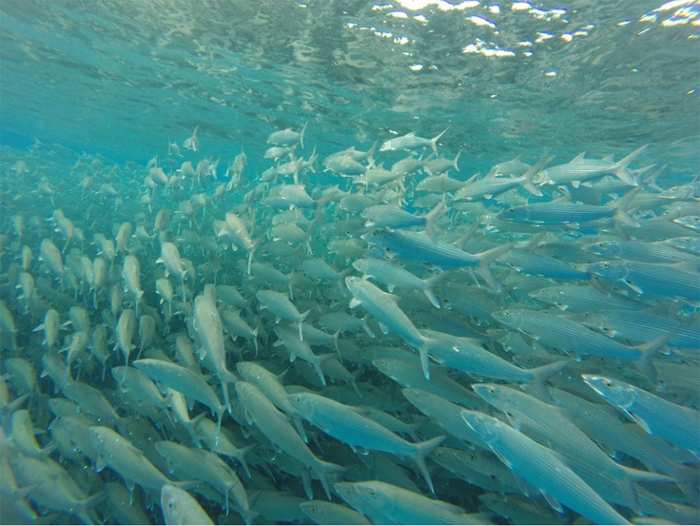
Bonefish on the move. Photo BTT/NatGeo/OPENEXPLORER
Conservation of a Prehistoric Fish: Bonefish [Albula vulpes]
By Aaron Adams / National Geographic OPENEXPLORER / July 16, 2019
Regional Conservation Implications: Part 1 – Oceanography.

Aaron Adams, Ph.D., at a 2013 Bonefish and Tarpon Trust Symposium held at the International Game Fish Association headquarters in Fort Lauderdale/Dania Beach, Florida. Photo by Skip Clement.
[dropcap]R[/dropcap]ecent technological advances have allowed oceanographers to reach a much better understanding of ocean currents. Bonefish and Tarpon Trust recently collaborated with a group of oceanographers to get a better idea of where bonefish larvae are likely to end up. We provided a map showing known and likely pre-spawning aggregation (PSA) sites for bonefish throughout the Caribbean. The known sites are where we had observed PSAs. The likely sites were either where PSAs had been reported by guides and anglers or where the geography matched what we had documented for the known sites. This included sites in The Bahamas, Cuba, Florida Keys, Belize, Mexico, Puerto Rico, U.S. Virgin Islands, and Vieques, Venezuela – all locations with known recreational bonefish fisheries.
The oceanographers then used computer models that are based on real readings of ocean currents to inject 100 ‘virtual bonefish larvae’ into the water at these sites at the full moons between November and April for a 5-year period, and kept the larvae in this virtual ocean for 53 days. This resulted in the paths of thousands of larvae being estimated by the computer models. The computer model study concluded that many larvae remain in the vicinity of where they were spawned, but that many are transported to distant location – the ratio of staying local vs distant travel differed among locations. In other words, to some extent, some local bonefish populations are responsible for a large portion of producing the next generation. But all populations receive larvae from other locations, and some populations receive a lot of larvae from other locations.
The oceanographic study results showed that Belize and Mexico likely provide a lot of larvae to the Florida Keys, and even the likelihood of larvae from southwest Cuba reaching the Keys. The study also estimated that depending on where bonefish in the Florida Keys spawn, the Keys bonefish population could depend almost entirely on larvae from elsewhere or provide a lot of its own larvae.
As you might expect, there is a high level of connectivity among the islands in The Bahamas, as well as between The Bahamas and the north coast of Cuba. And because the currents are so strong, it’s even likely that larvae from spawning in the eastern Caribbean, at Vieques, reached bonefish populations in the western Caribbean.

A tagged Albula vulpes. Photo: Justin Lewis of Bonefish & Tarpon Trust Bahamas.
More information from National Geographic OPENEXPLORER . . .
About Video
Bonefish and Tarpon Trust funded research trip on spawning bonefish in the Bahamas. Watch the incredible footage and share with others. Bonefish and Tarpon Trust is a non-profit conservation organization dedicated to protecting and conserving bonefish, tarpon and permit and their habitats around the globe. Please join the effort today by becoming a member, and help us protect these magnificent fisheries for tomorrow. Visit www.bonefishtarpontrust.org to learn more.






